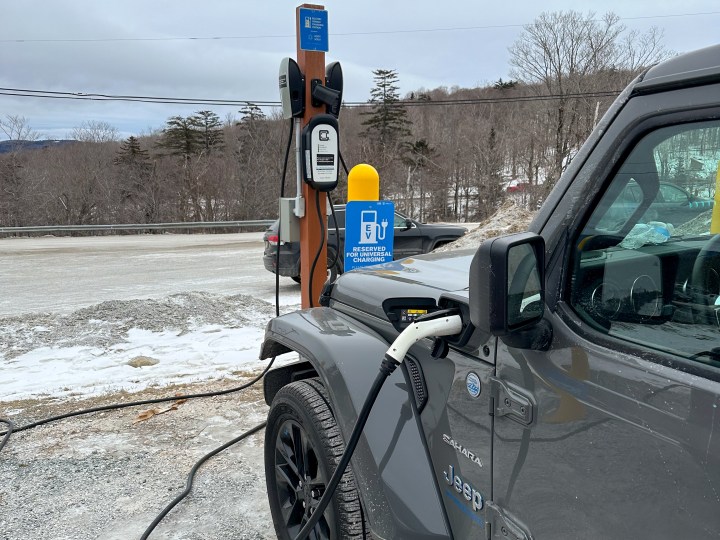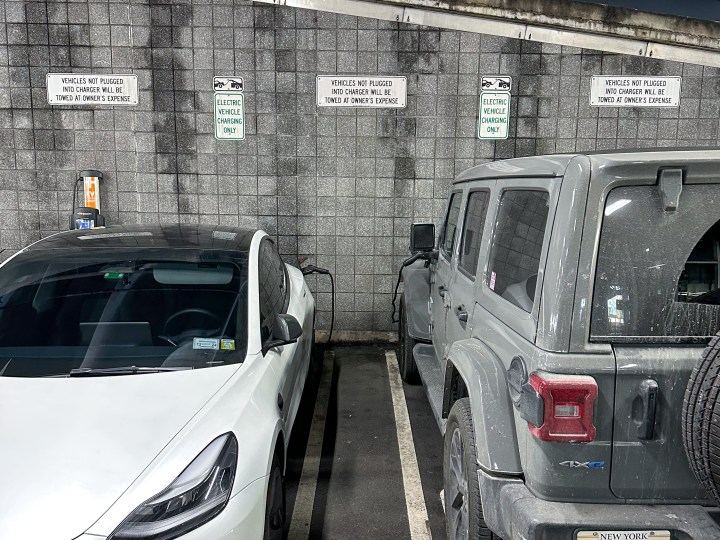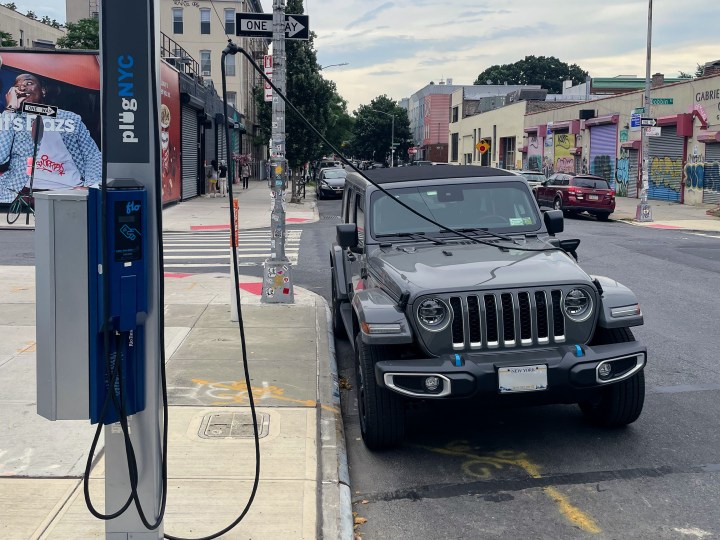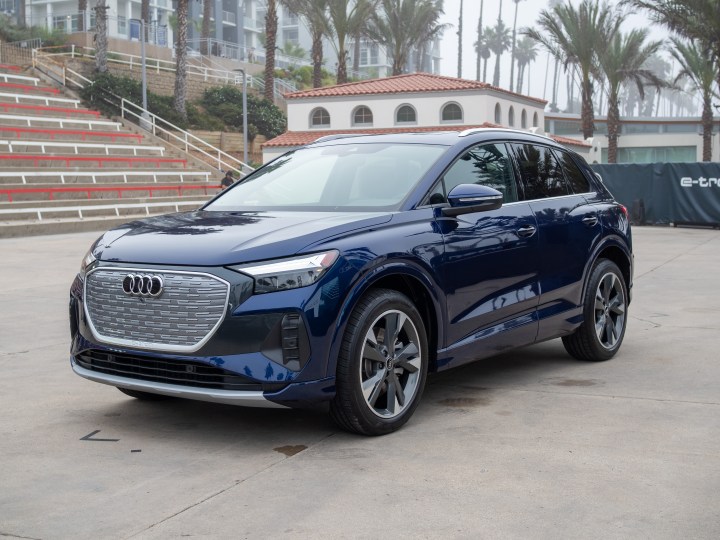A year ago, I bought a new Jeep Wrangler. A plug-in hybrid model! And I wasn’t shy about my reasoning for buying the PHEV version of the Wrangler: I chose this powertrain over the gas-only versions purely because it qualified for the federal government’s $7,500 EV tax credit.
Turns out, that was a pretty big motivator for a lot of Americans. The Jeep Wrangler 4xe was the best-selling plug-in hybrid (PHEV) in the U.S. in 2022, beating out a wide range of more affordable and practical cars. The 4xe accounted for nearly a quarter of Wrangler sales last year, which is just astonishing. But it passes the eye test — I see 4xes everywhere.
After a year and over 6,000 miles driving my Wrangler 4xe, I’ve unearthed the embarrassing state of urban EV charging, found a few unexpected perks, and completely reconsidered whether I’d buy an EV.
Not all PHEVs are created equal
“Plug-in hybrid” doesn’t guarantee great range or combined fuel economy — and the Wrangler 4xe is the shining example. To be entirely clear, I knew this going in. Driving a 5,000-pound truck with the aerodynamics of an office building using a 17kWh battery was never going to equate to much electric driving range. But it’s still a bit disheartening to set off on a drive with 100% charge and watch the battery percentage drop every minute. Even at around-town speeds, you’ll get little more than 20 miles driving in EV mode, and my combined efficiency for the last 6,000 miles is a meager 23 mpg. Based on what I’ve read online that’s better than most people driving the regular four- or six-cylinder gas models, but not by much.

Now and then I do see the value in it, even with the obvious limitations. I can make short trips around where I live in NYC on battery alone, which is a much more relaxing experience than listening to and feeling the gas engine constantly (the Wrangler isn’t known for its sound insulation). And it feels good to reduce the amount of pollution in the city, even if only a tiny amount. Even when you’re running the gas engine the hybrid system lets the engine cut out far more frequently than a typical auto start/stop system, turning off when coasting down hills and for several seconds pulling off the line from a stop.
The hybrid powertrain also offers a considerable power boost over the other Wrangler models (375 hp and 470 lb.-ft), which is seriously appreciated when getting this heavy truck up hills, passing on the highway, and quickly jumping up to speed on short city on-ramps. And contrary to popular belief, the electric motor’s power is still available even when your battery shows “<1%” in the dash — there’s always a notable amount of battery left in reserve to keep spinning that motor for short stints of power. Partly thanks to the aggressive regenerative braking, which will also save on brake pad and rotor maintenance over time.
The PHEV powertrain brings something to the table — but it isn’t efficiency.
Jeep isn’t letting up on building these so-called “compliance hybrids” anytime soon, so we should get used to it. Since I bought my Wrangler the company has launched a (slightly) more affordable Willy’s trim level of the Wrangler 4xe, as well as the Grand Cherokee 4xe with the same powertrain and middling efficiency. We won’t see all-electric Jeep models until the 2025 model year, and even at that point, the PHEVs aren’t going away. It’s easy to be cynical and continue to point out that these plug-in hybrids with tiny batteries and less-than-stellar fuel economy aren’t actually doing anything to help with our transition away from fossil fuel-burning vehicles. But it is helping the idea of plugging in your car permeate public consciousness — which is particularly tough among the dinosaur juice lovers that drive Jeeps.
Great parking spots

I regularly joke that my Wrangler 4xe’s hybrid battery is most useful as a free parking pass. Given how short the electric driving range is, filling up the battery alone isn’t worth seeking out a charger at every destination. But when there’s a nice bank of EV chargers in a prime parking spot, you can bet I’m taking advantage of the situation.
The airport parking garage has dedicated EV charging spots right next to the elevators. Ikea lets EVs park by the door rather than a football field away at the back of the parking lot. Many of my local ski resorts put EVs right next to the paid premium parking — for free. And NYC’s curbside chargers give you an opportunity to actually find a street parking spot — at least, in a handful of neighborhoods.
I don’t need to charge, but I sure do like the nice parking spots.
Yes, I recognize how antisocial this is. I do feel bad when I take a charging spot from someone in a Rivian or Tesla who needs that battery power to make it to their next destination. But y’know what? First come, first served. I have a charging plug, so I “belong” there just as much as they do. And I sure belong there more than the gas cars that constantly block chargers, which is acutely problematic in the crowded NYC area.
The sad state of public EV charging
I’ve noticed a steady increase in EV charger installations in the city over the last year, but the issues with broken, non-operational, blocked, and completely full chargers are still just as bad. There’s nothing even approaching a unified system for knowing where chargers are, if they’re available to the public, and whether they’ll actually be working when you get there. I’m also still blown away by the wide range of payment systems — by the hour, by the kW, or both — and the varying cost structures that can often be more expensive than just buying gas.

NYC is the densest city in the country, yet the charging infrastructure here is truly terrible. For a city battling with car emissions and eyeing strict environmental laws, it’s appalling how little it has done to support EVs. Private garages often charge $100 to $200 per month just to charge your EV (a roughly 20% premium over what you pay to park), and most garages have just a handful of EV chargers to share among hundreds of monthly and daily parkers.
There are a grand total of 41 public EV charging stations in NYC, a city of 9 million people.
For the vast majority of people who don’t park in a private garage, public charging options are shockingly limited. There are just 35 public curbside charging stations across the five boroughs (and mostly just in three), where you’ll pay $1 to $2.50/hour for a measly 6.2kW charge. And there are only six public DC Fast charging stations. There are still 18 gas stations in Manhattan alone. In a city of roughly 9 million people, this little investment in public EV charging is insulting. And it’s the biggest reason to be hesitant about moving to an EV.
I won’t be buying an EV anytime soon
Owning a PHEV convinced me I won’t be buying an EV anytime soon. Like most tech-forward people I was initially considering buying an EV — but I’m so glad I went with a PHEV so I could see all of the ups and downs of EV life, without actually having to rely on it. Now that I can plug in, and I try to charge as often as possible, I can see just how frustrating it would be to own an EV right now — particularly in NYC and for how I drive.

I don’t have a car commute. When I drive, the trip is either incredibly short around the city or incredibly long to escape it. I regularly make straight-shot 200 to 250-mile drives from home, which is theoretically no problem for the range of modern EVs … until you remember you have to charge. In the places I typically go, you can find slow Level 2 chargers scattered around, but you’re lucky to find a Level 3 or DC Fast charger within 50 miles. Open Tesla Superchargers can help, but can’t fix this problem alone.
And that’s if I’m even able to start my trip at 100% battery, which it’s clear I’ll struggle to do — at least in any sort of cost- or time-efficient manner. I have zero desire to voluntarily add any of this charging anxiety to my travels. And remember, I’m a nerd who’s willing to plan ahead and troubleshoot tech — imagine if I was a normal person.
I’m glad I bought a PHEV, because it showed me all of the reasons why I’m not ready for a full EV.
I would absolutely buy another PHEV. I’d go so far as to say I’d only buy a PHEV as my next car. I enjoy the ability to drive electric-only, like the extra power on tap, and deal with zero range anxiety or charging concerns. The best PHEVs being made today already offer 40-plus mile EV range, and that’s only going to get better by the time I buy my next car. I have much more faith in the advancement of PHEVs than I do in the advancement of charging infrastructure in the U.S., looking two to three years ahead. That’s unfortunate for those who really do want to drive an EV, but it’s the reality of the situation and I’m not going to die on this hill.
Editors' Recommendations
- 4 ways the best-selling plug-in hybrid in the U.S. just got better for 2024
- Chinese automaker Zotye wants to start selling cars in the U.S. within two years





